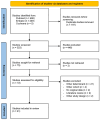Follicle-Stimulating Hormone Receptor Expression and Its Potential Application for Theranostics in Subtypes of Ovarian Tumors: A Systematic Review
- PMID: 38539473
- PMCID: PMC10969425
- DOI: 10.3390/cancers16061140
Follicle-Stimulating Hormone Receptor Expression and Its Potential Application for Theranostics in Subtypes of Ovarian Tumors: A Systematic Review
Abstract
Ovarian cancer mortality rates have not decreased significantly in the past years. As most women are still diagnosed in an advanced stage, there is a need for new treatment strategies for recurrent disease. A potentially new developing targeted approach, theranostics, combines diagnostics and treatment using radiopharmaceuticals. Through target receptors, imaging and treatment of malignant tissue can be achieved. For ovarian malignancy, the follicle-stimulating hormone (FSH) receptor may serve as a possible target since expression appears to be limited to ovarian cells. In this systematic review, we aim to gather all available literature on the expression of the FSH receptor in ovarian tumors. Pubmed, Embase and the Cochrane databases were searched until December 2023 for eligible studies. The search yielded 41 studies, mostly regarding serous carcinomas, sex cord-stromal tumors (SCSTs) and cell lines of serous and SCSTs. Various techniques were used to analyze the expression of the FSH receptor. For serous carcinomas, conflicting results on the expression of the FSH receptor were found. Studies on SCSTs, mainly studying the subtype of granulosa cell tumors, all showed positive expression of the FSH receptor. In the cell lines studies, the KGN cell line derived from a granulosa cell tumor shows positive expression in all studies. Available studies show that SCSTs express the FSH receptor. A theranostic approach targeting the FSH receptor may, therefore, provide a useful new approach for this malignancy with limited therapeutic options in recurrent disease.
Keywords: FSH receptor; ovarian cancer; theranostics.
Conflict of interest statement
A.J.A.T.B. reports fees for grants/contracts from Boston Scientific and Terumo for consultant and research support and from Ariceum Therapeutics for research support. The other authors declare no conflict of interest.
Figures




References
-
- Adhikari L., Hassell L.A. WHO Classification. [(accessed on 8 February 2023)]. Available online: https://www.pathologyoutlines.com/topic/ovarytumorwhoclassif.html.
Publication types
LinkOut - more resources
Full Text Sources
Other Literature Sources
Research Materials
Miscellaneous

